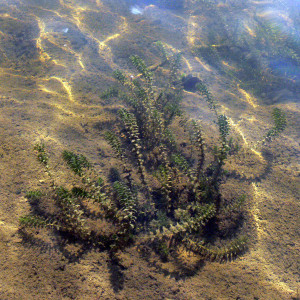 Elodea grows everywhere, and is especially abundant in still and quiet waters. The entire plant is submerged. The root system is underdeveloped. The branching shoots can reach up to 100 cm in length. The simplistic smallish and thin leaves grow in whorls of three round the stem. In July-August, in the upper leaf bases small flowers with whitish petals and three pale reddish sepals occur.
Elodea grows everywhere, and is especially abundant in still and quiet waters. The entire plant is submerged. The root system is underdeveloped. The branching shoots can reach up to 100 cm in length. The simplistic smallish and thin leaves grow in whorls of three round the stem. In July-August, in the upper leaf bases small flowers with whitish petals and three pale reddish sepals occur.
The Canadian waterweed got its name from its region of origin – Canadian water bodies. It was initially brought to Europe via Scotland in 1842 by ships and steamers. Since then, elodea has been quickly spreading through the water systems of Europe, at some point emerging in Russia. Sometimes the plant referred to as the water plague. This aquatic plant is capable of fast propagation – each off-shoot broken off may become a new plant. Its buds, stuck on to waterfowls, are transferred across water bodies. Large overgrowths of elodea choke other aquatic vegetation and may be detrimental to navigation and fishery.
The waterweed flowers rarely – in Europe and Russia only the female plants with pistillate flowers are widespread. In the absence of staminate flowers, the pollination does not occur and neither does fruition.
The plant grows well in aquaria, and its overgrowths can be used as fertilizers or pig fodder.
/ * The photos at lake.peipsi.org are cross-posted from commons.wikimedia.org and are used for familiarization purposes only. No commercial use of the photos is allowed. For more information about to use the photos see the originals on commons.wikimedia.org. /


